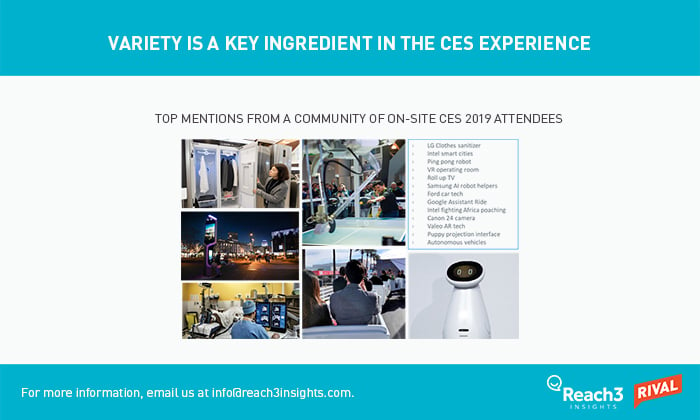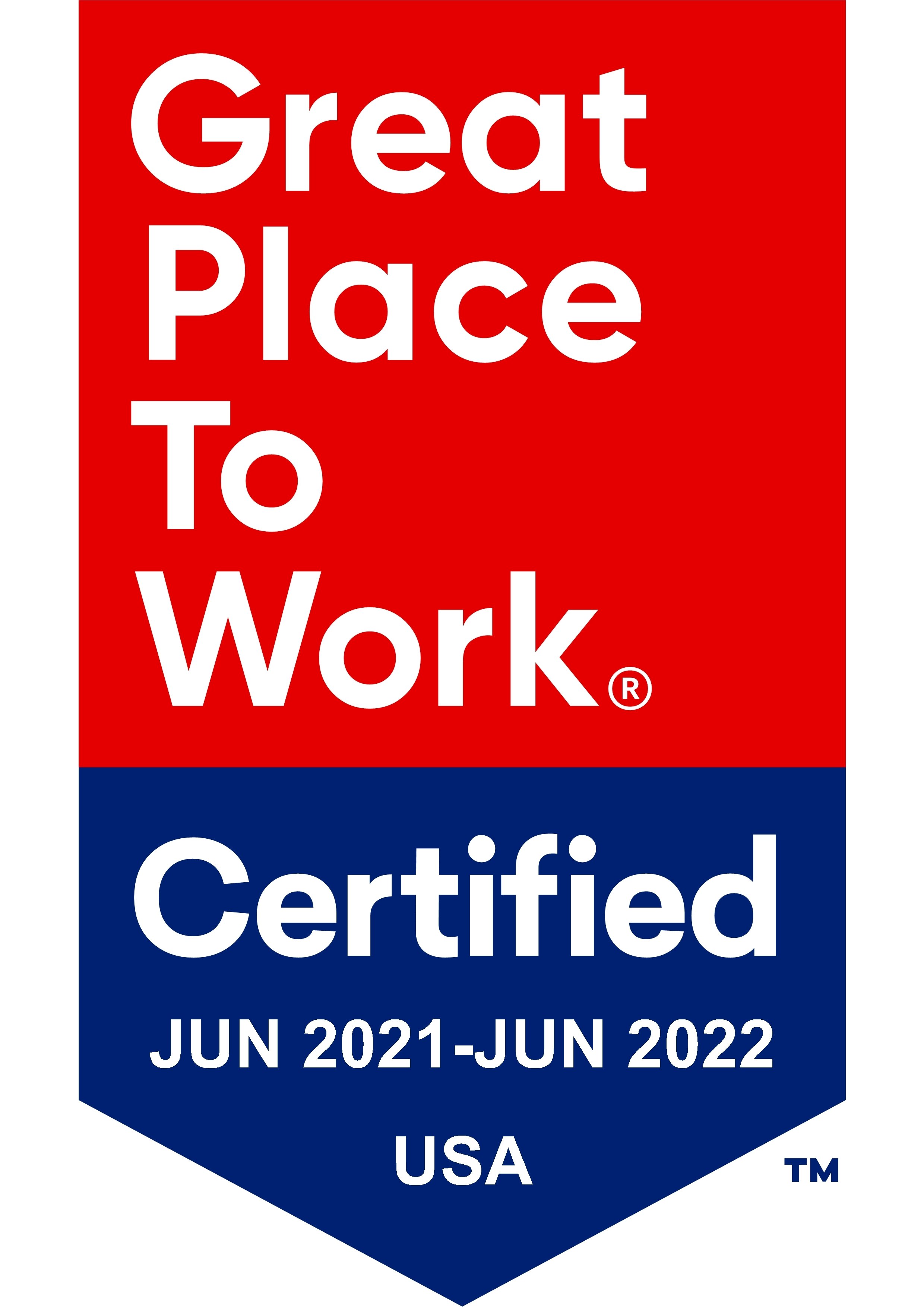Sending your surveys a day or two after the show means you’re relying heavily on people remembering their experience accurately.
For 50 years now, the Consumer Electronics Show (CES) has become a place for tech companies to showcase next-generation innovations. Some of the technologies launched in CES—the VHS in 1970, HDTV in 1998, wearables in 2017, etc.—went on to transform the consumer landscape and shape new behaviors. But in a fast-moving world where many tech companies now hold their own conferences several times a year and could easily communicate directly with consumers, what role, if any, does the CES have?
That’s one of the key questions we explored in a recent Reach3 Insights study. Using tools from our sister company, Rival Technologies, we recruited 50 attendees during this year’s CES, asking for their real-time feedback by sending them chat surveys throughout the show. We recruited attendees from Twitter, Facebook, LinkedIn and on-site intercepts. In additioon to answering our questions, attendees also provided a number of photos and selfie videos.
Our motivation for doing this study was twofold. Since we work with many tech companies, we were genuinely interested in knowing whether CES is still a valuable show for our clients. Just as important, we wanted to further explore methods that use more immersive and conversational approaches to getting attendee feedback in-the-moment while they’re physically at the event.
Sponsoring an event is expensive, and more companies are wondering how to best measure the ROI of their event-marketing investments and understand what is working and what isn’t and why. If brands get an ROI metric somehow, they often don’t know if it’s real or lack the WHY behind it. Another issue: the traditional way of doing research on event and sponsorship effectiveness relies heavily on post-event surveys and recall—a problematic approach that not only impacts response rates but also the accuracy of insights. We have seen early successes in collecting event feedback live from the floor and felt CES was a good opportunity to further explore.
The traditional way of doing research on event and sponsorship effectiveness relies heavily on post-event surveys and recall.
To address our first goal, let’s explore some key takeaways we learned about CES.
It’s all about the experience
For many attendees, CES provides an opportunity to get up close and personal with the cutting edge of tech. But the new innovations featured during the show are just one part of CES—equally important is the experience attendees have for being there in person.
“So much cool stuff and fun things to see,” one attendee told us via chat survey. “I’ve had so much fun!”
Google is one that seems to understand how CES centers around experience. The company not only had a presence in multiple different parts of the show, it also ensured it would be the talk of the show by building an entire theme park-style dark ride.
This year’s CES delivered a great experience, according to the attendees who participated in our chats. Nearly all of them reported it as being a good show and no one said it was bad. Two-thirds said CES 2019 exceeded their expectations—especially those who were attending for the first time. Interestingly attendees said the success of the show is about the whole experience—the spectacle and first-hand access to new technology—rather than any one specific announcement.
The big range of new gadgets is part of what makes CES so interesting.
Indeed, variety is a key ingredient in the CES experience. While media publications tend to heavily cover new TVs and phones announced at the show, for those who were in Vegas, the big range of new gadgets is part of what makes CES so interesting. When asked what attendees thought was the most exciting news, not a single person overlapped in what they chose. The responses also covered a variety of industries and niches—from LG's clothes sanitizer, to Puppy Robot's smart projectors, to Intel fighting poachers in Africa.

It’s more about technology—and less about the party
Even though Vegas is known for a bit of debauchery, most CES attendees kept it low key after the show. In terms of night plans, two-thirds of the attendees who took our chats said they had dinner with their teams and then called it a night. After the show seems to be time to regroup and plan with their own teams rather than prospective customers or clients—nearly all post-show plans involved just their own team and not any clients, suppliers or prospects.
From “what was trending” perspective, intelligent tech topped this year's CES. While the most interesting topic is somewhat spread out, robotics sparked the most interest in about a third of the attendees, followed closely by smart homes and AI. First time attendees, in particular, were enamored with robotics, while more veteran CES attendees gravitated to smart home and product design & manufacturing
Big brands generated the biggest buzz. Even though it didn't necessarily announce anything all that new or groundbreaking, Google made its presence known, as we mentioned above. Attendees picked the company as having the most impact, likely due to branding for Google Assistant being tucked into just about every nook and cranny of CES.
Other than Google, LG and Intel also made a good impression—the former for its new 8K OLED TV and innovative clothes sanitizer, and the latter for for its collaboration in smart cities and AI-enabling technologies.
Some room for improvement
The biggest suggestions as to how CES could improve centered around navigation. CES is so sprawling and massive—attendees said they’d like to see improvements to knowing where companies are, what demos are available, and having the event app be truly comprehensive. The paper maps and app provided by the event did a fine job but most attendees felt there was room for improvement. Expansion of the shuttle service to more locations would be a welcome upgrade as well.
By providing a great in-person experience, CES could still play a key role in helping companies build a relationship with tech enthusiasts.
Overall, our study shows that by providing a great in-person experience, CES could still play a key role in helping companies build a relationship with tech enthusiasts. Not everyone can afford to go to CES, of course, but industry people who attend can represent other tech enthusiasts and help start word of mouth.
Getting real-time insights from live events
As mentioned in the intro, this exercise provided some interesting takeaways on how to engage attendees during live events:
1. Rely less on recall
For the most part, market researchers tend to rely on post-event surveys to understand the attendee experience. But sending your surveys a day or two after the show means you’re relying heavily on people remembering their experience accurately. We believe that engaging attendees in quick chat surveys during the event is more effective. This approach means people don’t have to remember what they did a few days before—it also helps capture stream-of-consciousness feedback—which, in many cases, is more authentic and less reliant on people rationalizing their responses.
2. Keep your chats or surveys short
This is related to the previous point. Since you’re engaging people while they are at the event, don’t expect them to spend more than a few minutes on your surveys. Attendees would want to do your chats quickly and get back to the event right away. Also, people will be answering your chats using their phones—so long surveys are out of the question.
There’s no reason to keep your activities long anyway—if people are subscribed to your chats, you can reach out again during the conference. In addition to being short, chats should also be fun and interesting to keep attendees engaged.
3. Go multi-media
For some attendees, submitting a photo or a video might be faster than typing on their phones. In our analysis, having photos and selfie videos submitted by attendees also proved very useful, providing additional color and context to text responses.
If you are sponsoring an event and evaluating its effectiveness, photos and videos can provide insights hard to capture via text alone. For instance, you could ask on-the-ground attendees to visit your booth and ask them to take a photo of what they liked, what messaging resonated, which swag captured their attention, etc. Another idea is to create mobile missions asking attendees where they see sponsor logos. This can help you optimize your tactics in the future.
Conclusion
The purpose of this study wasn’t just to explore attendees’ attitudes towards CES; we also wanted to examine the efficacy of in-the-moment approaches to understanding attendee satisfaction and sponsorship ROI. The quality of insights we got suggests that engaging attendees in real-time is a promising way of capturing more accurate and richer insights, but this approach is most effective if the respondent experience is seamless and quick.

Leigh Admirand
EVP & Founding Partner, Reach3 Insights







.webp?width=65&height=83&name=A-LIGN_HIPAA%20(1).webp)

